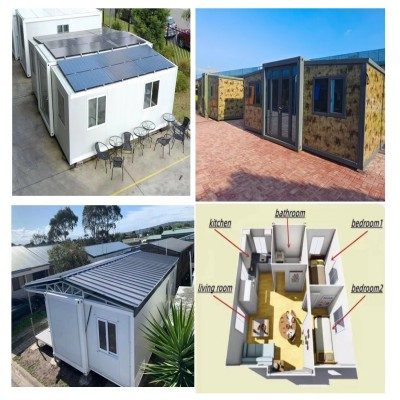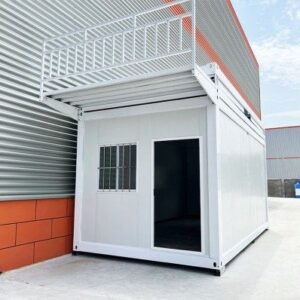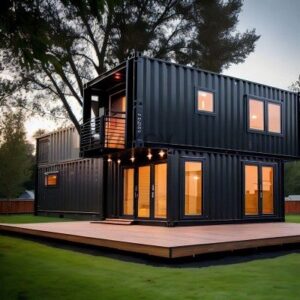Average Cost Breakdown How Much To Build A Container House
Building a container house involves several cost components that add up beyond just buying the containers. Understanding these costs helps you budget smartly and avoid surprises.
Raw Container Costs New and Used Price Ranges
The starting point is the cost of the shipping containers themselves. New containers typically run between $3,000 to $6,000 each, depending on size (usually 20 or 40 feet) and condition. Used containers are more affordable, often priced around $1,500 to $3,000, but may need more work like rust repair or cleaning. Selecting new vs. used impacts not only upfront costs but also future maintenance.
Site Development Costs
Preparing your land involves tasks like grading, foundation work, and utility hookups. Site development can cost anywhere from $5,000 to $20,000 or more, depending on location and terrain complexity. This includes permits and inspections tied to your local regulations.
Structural Modifications and Fabrication
Containers usually need structural changes to create doors, windows, or combine multiple units. This custom work can cost between $10,000 and $30,000 depending on the design complexity and cutting required. Fabrication also includes strengthening the container to maintain integrity after modifications.
Installation and Labor
Labor costs vary widely across the U.S. but typically run from $15,000 to $40,000 for delivering, setting, and securing containers on-site. Skilled labor is needed for welding, framing, and detailed assembly. Working with experienced contractors, such as those familiar with container homes, will ensure safety and quality.
Interior Finishing and Appliances
The cost to make your container livable includes insulation, flooring, plumbing, electrical wiring, cabinetry, and appliances. Expect a range of $20,000 to $50,000 depending on the finish quality and customization level. Features like energy-efficient windows or smart home tech add to the cost but save money long-term.
Utility Connection Costs
Hooking up to water, power, and sewage runs typically costs between $5,000 and $15,000, depending on how close your site is to existing infrastructure. Off-grid solutions like solar panels or septic tanks can also be options but have their own price tags.
Contingency Funds and Unexpected Expenses
Always factor in a contingency budget of 10% to 20% for unforeseen expenses such as permit delays, material price changes, or hidden repairs. Container house projects often uncover surprises once construction is underway, making a financial cushion essential.

Cost Comparison Container House vs Traditional Home Construction
When weighing how much to build a container house against a traditional home, the numbers and benefits reveal clear differences.
Per Square Foot Cost Analysis
Container homes typically cost $150 to $250 per square foot, depending on design and customization. In contrast, traditional homes in the U.S average around $200 to $400 per square foot, influenced heavily by materials, labor, and location.
| Aspect | Container House Cost (per sqft) | Traditional Home Cost (per sqft) |
|---|---|---|
| Base construction | $100 – $150 | $150 – $300 |
| Interior finishing | $40 – $80 | $50 – $100 |
| Permits & fees | $5 – $10 | $10 – $20 |
| Utilities & utilities | $10 – $20 | $20 – $40 |
| Average total | $150 – $250 | $200 – $400 |
Container homes offer a lower starting point mainly because the structure is pre-built, which cuts down on raw material and framing costs.
Time Savings and Financial Benefits
Container house construction usually takes weeks to a few months, while traditional homes can stretch 6 months to over a year. This faster timeline means:
- Lower labor costs
- Quicker move-in and potential rental income
- Fewer financing charges during construction
The ability to prefabricate container units off-site speeds up the process substantially.
Long-Term Savings from Energy Efficiency
Many container homes integrate energy-efficient materials, solar panels, and modern insulation. The compact design also makes heating and cooling more affordable. This translates to:
- Up to 30% reduction in utility bills vs traditional homes
- Lower maintenance costs thanks to durable steel containers
- Potential tax incentives for sustainable building features
These ongoing savings improve the overall cost-effectiveness beyond the initial price tag.
What Is a Container House
Definition and Basic Concept
A container house is a type of dwelling built using large steel shipping containers as the primary structural element. These homes turn standard freight containers into livable spaces, offering a modern, affordable, and eco-friendly alternative to traditional construction. They can serve as single-family homes, offices, vacation cabins, or even multi-unit complexes.
Types of Shipping Containers Used
Most container houses are constructed from either new or used shipping containers, with common sizes including:
- 20-foot containers (about 160 square feet)
- 40-foot containers (about 320 square feet)
Used containers are typically more affordable but may require more refurbishment to meet housing standards. New containers offer a clean slate but come with a higher price tag. Choices between the two affect both cost and durability.
Yichen Expertise in Container House Solutions
At Yichen, we specialize in delivering innovative container house solutions tailored to your vision. With wide experience in customizing both standard and prefabricated container homes, Yichen helps optimize container house design, construction, and budget. Whether you’re curious about a modern container house or need advice on building with 20-foot containers, our expertise streamlines the process from concept to completion.
For more on container options check out Yichen’s Modern Container House and 20ft Shipping Container House.
Factors Influencing the Cost of Building a Container House
When planning the cost to build a container house, several key factors come into play. Understanding these can help you prepare a realistic budget and avoid surprises along the way.
Size and Number of Containers Used
The size and number of shipping containers you choose directly impact your overall cost. A single 20-foot container will be cheaper than multiple containers combined into a larger structure. Larger homes or multi-container setups require more materials, more complex connections, and additional labor.
Customization and Design Complexity
How much you customize your container house plays a big role in price. Basic layouts with minimal modifications cost less, while adding extra windows, doors, or unusual shapes will increase construction costs. Complex interior designs, built-ins, and unique architectural features also add up.
Location and Site Preparation
Where you build affects costs for land preparation, foundation work, and utility connections like water, electricity, and sewage. Rocky or uneven terrain usually requires more work. Urban versus rural settings can cause price shifts due to access and local regulations.
Labor Costs and Contractor Fees
Labor rates vary broadly across the US. Hiring skilled contractors to modify containers, handle electrical and plumbing work, and complete finishing tasks can be costly depending on your area. Labor-intensive projects with complex designs will require higher budgets.
Permits and Legal Requirements
Obtaining necessary building permits and adhering to local codes can add to your expenses. Some locations have strict rules about container homes, requiring special approvals, inspections, or additional paperwork. Budget time and money for legal compliance.
Interior Finishing Expenses
Once the container shell is ready, interior work adds more costs. Proper insulation, flooring, plumbing, electrical wiring, and fixtures significantly affect pricing. High-end finishes or eco-friendly materials will increase your spend, while simpler options can keep costs down.
Sustainability Features and Smart Technologies
Adding green energy systems such as solar panels, rainwater harvesting, or smart home tech will boost the price upfront. However, these features often save money long-term through lower utility bills and increased home value.
By carefully considering these factors, you can better estimate the container house construction cost per square foot and plan a home that fits your budget and lifestyle. For affordable options and design ideas, check out small container house solutions or prefabricated container homes.
Budgeting Tips to Build an Affordable Container House
Building a container house on a budget means being smart about where you spend and where you save. Here are practical container home budgeting tips to help keep costs manageable without sacrificing quality.
Start With a Clear Scope and Design
- Define your needs first: Know how many bedrooms, bathrooms, and living spaces you really require. This avoids costly changes later.
- Simple designs cost less: Complex layouts increase structural work and materials. Stick with straightforward container combinations to reduce expenses.
- Plan for expansion: If you want to grow later, design your container home to allow easy additions.
Prioritize Essentials Over Luxury Features
- Focus spending on well-insulated walls, solid flooring, and reliable plumbing/electrical systems.
- Postpone non-essential luxury finishes like high-end appliances, custom cabinetry, or advanced smart tech until after basic construction.
- Opt for durable, affordable materials that meet local building codes.
Leverage Modular and Prefabricated Container Solutions
- Use prefabricated container modules, which Yichen offers, to cut fabrication time and onsite labor costs.
- Modular units simplify approvals and reduce waste compared with fully custom builds.
- Prefab container houses often come with tested specs which mean fewer surprises and budget overruns.
Explore DIY Options and Cost-Saving Hacks
- Take on partial DIY tasks such as painting, interior finishing, or landscaping to reduce labor fees.
- Consider sourcing used containers in good condition — they usually cost less than new ones.
- Bulk buy materials and local suppliers to save on delivery and markup.
Choose the Right Contractor or Builder
- Hire contractors experienced in shipping container house construction to avoid costly mistakes or redesigns.
- Request detailed bids and check references specifically for container home projects.
- Favor builders who understand local permits and zoning rules, so you won’t get stuck with fines or delays.
- Sometimes, partnering with a company like Yichen that covers design, build, and financing can simplify budgeting.
By focusing on these tips, you can keep your container house building costs reasonable while still getting a durable, comfortable home. For detailed information on container house designs and pricing, you can check how much is a container house or explore prefabricated container options.
Financing and Incentives for Container Houses
Loan Options for Building a Container House
Finding the right financing for a container home can be a challenge because traditional mortgage lenders often don’t treat these homes like conventional houses. However, several loan options are available for container house projects:
- Personal and Home Improvement Loans: These loans can be easier to qualify for and are flexible for unconventional homes.
- Specialty Lenders: Some lenders specialize in alternative and tiny homes, including container houses, offering tailored terms.
- Construction Loans: If you’re building a multi-container or custom project, construction loans can cover the build costs before converting to a mortgage.
It’s important to have a clear project plan and cost estimate when applying, which helps lenders assess the viability of your container house.
Grants and Incentives for Sustainable Container Homes
Building with shipping containers often aligns well with sustainability goals. This makes you eligible for energy efficiency grants and incentives, helping reduce overall costs:
- Federal and State Energy Credits: Programs like the Federal Residential Renewable Energy Tax Credit can apply if you include solar panels or energy-efficient systems.
- Local Green Building Incentives: Some states and municipalities offer rebates or tax benefits for sustainable construction methods and materials.
- Sustainability Grants: Nonprofits and environmental organizations sometimes provide grants for eco-friendly housing projects.
Leveraging these incentives can significantly offset the initial container home construction cost, especially when combining green technologies with smart design.
How Yichen Supports Financing and Project Planning
At Yichen, we’re not just about building container homes — we also help you navigate the financial and planning parts of your project. Our team offers:
- Guidance on financing options that fit your budget and goals, making it easier to secure loans or locate grants.
- Detailed project planning and cost breakdowns, helping you understand each expense and prepare your financing applications.
- Support with permits and regulations, smoothing out legal hurdles that could impact your project financing.
If you’re considering a container house, we encourage you to explore our resources and talk with us about how to make your build affordable and achievable. For more detailed pricing info, check out our container house cost guide.
Real World Examples of Container House Costs and Success Stories
Seeing container homes built and lived in gives the best insight into what building a container house really costs and how well these projects turn out. Here are some practical examples and details from actual projects that showcase cost breakdowns and customer experiences, including work done by Yichen, a trusted name in container house solutions.
Typical Container House Projects with Cost Figures
- Single Container Starter Home
- Size: 320 to 350 sq ft (1 to 1.5 containers)
- Total Cost: $35,000 to $50,000
- Includes: Used container purchase, basic insulation, electrical, plumbing, simple foundation, and interior finishes
- Common for tiny homes or backyard offices
- Multi-Container Family Home
- Size: 1,000 to 1,500 sq ft (3 to 5 containers)
- Total Cost: $120,000 to $180,000
- Includes: New containers, advanced design customization, smart tech integration, energy-efficient insulation, and landscaping
- Ideal for permanent housing with all modern comforts
- Luxury Modular Container Home
- Size: 2,000+ sq ft (6+ containers)
- Total Cost: $250,000+
- Features: High-end finishes, custom modifications, solar power systems, smart home tech, and professional interior design
Before and After Project Photos
Yichen’s portfolio offers clear visual proof of transformation from raw shipping containers to sleek, livable homes. You can see:
- The initial placement and structural modifications of containers
- Installation of insulation and weatherproofing layers
- Complete interior setups with flooring, kitchens, and fixtures
- Finished homes blending with the natural environment
These photos highlight the real functionality and modern appeal of container homes built at various budget points.
Customer Testimonials on Container House Building Costs and Experience
- “Building with Yichen was transparent and cost-effective. They helped me understand every expense, from container purchase to finishing touches.” – Jessica R., Texas
- “Our multi-container home took around six months, and the team managed permits and local regulations smoothly, keeping costs on track.” – Mike S., Oregon
- “We started with a tight budget but prioritized essentials as Yichen suggested. The end product is a durable, affordable home that fits our lifestyle perfectly.” – Lauren T., Florida
These testimonials emphasize the value of planning, local knowledge, and experience when managing container home costs.



